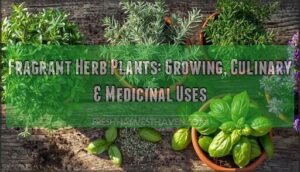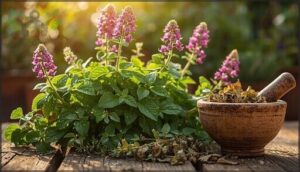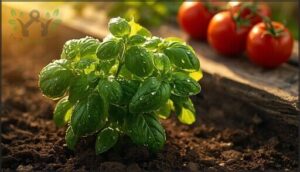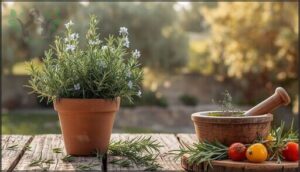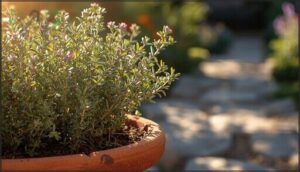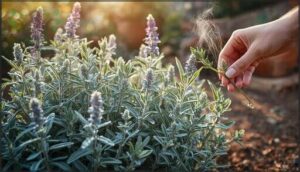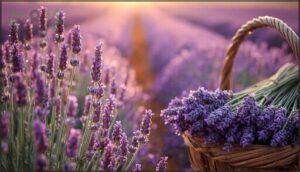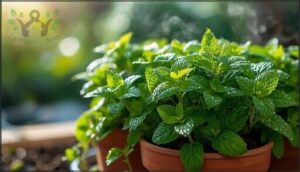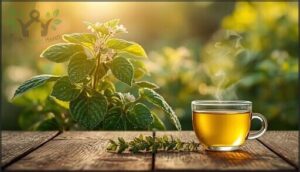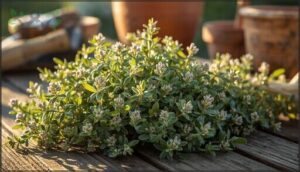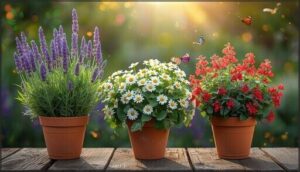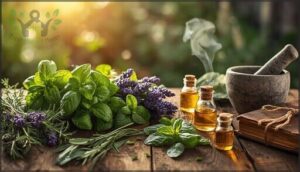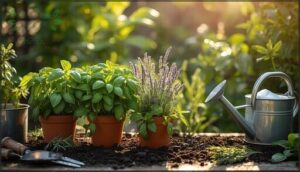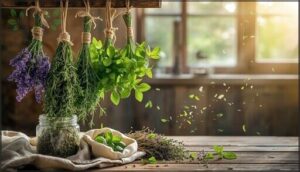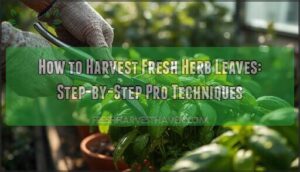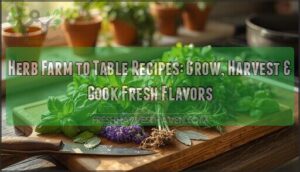This site is supported by our readers. We may earn a commission, at no cost to you, if you purchase through links.
You can tell when you’ve brushed past oregano or crushed a sprig of rosemary between your fingers. That immediate rush of scent isn’t just pleasant—it’s a concentrated blend of essential oils that can contain up to 2.5% pure aromatic compounds. Fragrant herb plants release these volatile oils as a defense mechanism, but gardeners have turned this botanical strategy into culinary gold and medicinal remedies that span centuries.
Whether you’re chasing the peppery punch of fresh oregano on roasted vegetables or the calming linalool in lavender that genuinely eases tension, these plants deliver more than decoration.
Growing them means understanding their specific needs for sunlight, soil drainage, and harvest timing—because picking basil at the wrong hour or drying thyme incorrectly can cost you half the fragrance you worked months to cultivate.
Table Of Contents
- Key Takeaways
- Most Popular Fragrant Herb Plants
- Aromatic Herbs With Beautiful Flowers
- Culinary and Medicinal Uses of Fragrant Herbs
- Growing and Caring for Fragrant Herb Plants
- Harvesting, Drying, and Using Scented Herbs
- Frequently Asked Questions (FAQs)
- What is a fragrant herb garden?
- What is a good fragrance plant?
- What shrubs are good for fragrance?
- Are herbs good for a garden?
- What flowers smell good?
- What flowers have a fragrant scent?
- What is the most fragrant herb plant?
- What herb smells like perfume?
- What is the mother of all herbs?
- What is an aromatic herb with winter and summer varieties?
- Conclusion
Key Takeaways
- Harvest fragrant herbs just before flowering when essential oil concentrations peak—basil loses 50% of its aroma within hours if you don’t refrigerate it immediately, and waiting too long costs you months of cultivation effort.
- Most culinary herbs need 6–8 hours of direct sunlight and well-drained soil with pH between 6.0–7.0 to produce maximum fragrance, with proper conditions boosting essential oil output by 10–40% compared to suboptimal growing environments.
- Air-drying herbs in shade with good airflow preserves 65–90% of their aromatic compounds, while temperatures above 40°C strip away 20% of the volatile oils that give thyme and rosemary their signature scent.
- Oregano and thyme contain antimicrobial compounds like carvacrol and thymol that fight foodborne pathogens, while lavender’s linalool content genuinely reduces anxiety through measurable effects on brain chemistry—these aren’t just pleasant smells but concentrated therapeutic compounds.
Most Popular Fragrant Herb Plants
Some herbs just have that unmistakable power to transform a space with their fragrance the moment you brush against them. These are the plants that anchor herb gardens, kitchens, and even windowsill collections because they deliver bold aromas and reliable growth.
Here are nine fragrant herbs you’ll want to grow, whether you’re building your first garden or expanding an established bed.
Oregano
Oregano thrives in full sun and delivers bold, peppery flavor that comes from carvacrol and thymol—compounds behind its culinary pungency and antimicrobial activity. You’ll harvest the most fragrant leaves just before flowering, when essential oils peak. Proper drying methods preserve up to 80% of its aroma.
Companion planting and horticultural oils help with pest management. Different oregano chemotypes offer varied intensity for flavorful herb recipes in your medicinal and culinary herb gardening adventures.
To confirm the reliability of oregano’s medicinal claims, one might consider conducting systematic reviews.
Basil
While oregano packs a punch, basil brings sweet warmth to your garden—a fragrance shaped by linalool and eugenol in concentrations that vary widely across basil varieties. You’ll notice aroma compounds peak within ten minutes of crushing fresh leaves, then fade fast.
Refrigerate harvested basil to slow post-harvest aroma loss by 50%. Pair it with tomatoes for classic culinary pairings, and grow it in full sun with well-drained soil for ideal essential oil production in your herb gardening journey. Basil varieties represent a specific area of herb gardening.
Rosemary
If you want a pine-scented rebel in your fragrant herbs garden, rosemary delivers. You’ll find rosemary cultivars packed with essential oil—up to 2.5% of dry weight—making culinary intensity shine in roasted dishes. This herb gardening favorite thrives with drought tolerance, needing 30% less water than others.
For aroma preservation and medicinal properties of herbs, harvest just before flowering when:
- Terpenoid concentration peaks in leaves
- Piney compounds reach maximum strength
- Culinary uses of herbs gain boldest flavor
Thyme
From rosemary’s pine kick to thyme’s savory warmth, your herb gardening just leveled up. Thyme varieties pack 20% to 60% thymol concentration, giving culinary herbs their medicinal punch and bold thyme aroma.
You’ll harvest peak thyme flavor just before flowering, when fragrant herbs hit maximum oil content. Thyme cultivation thrives in sunny, well-drained spots with pH 6.0–8.0, making it foolproof for beginners seeking reliable medicinal herbs with zero fuss.
Sage
Crush a sage leaf between your fingers and you’ll release a fragrant rush of camphor and pine—that’s thujone and cineole at work in culinary sage varieties.
Growing sage demands 6–8 hours of sun and well-drained soil for peak sage aroma.
Harvest just before flowering when essential oils hit 1.0% to 3.5%, and your culinary herbs and medicinal sage will deliver serious flavor.
Lavender
Lavender transforms your garden into a fragrant haven that soothes both mind and soil. You’ll get the best essential oil production from these aromatic plants when you provide 6–8 hours of sun and well-drained, alkaline soils.
- Choose lavender cultivars with 60–70% linalool for therapeutic uses and sachet crafting
- Space plants 18–24 inches apart for thriving landscape uses
- Harvest at early bloom when fragrance peaks
- Prune after flowering to strengthen next season’s herbal remedies and fragrant herb gardening success
Mint
Mint varieties deliver a crisp, cooling fragrance that’s hard to match in your herb garden. You’ll obtain essential oil concentrations of 0.5–1.5% when you plant in zones 4–11, making these aromatic plants reliable for herbal remedies year-round.
Growing mint means containing its vigor—pot it up to prevent takeover—while enjoying culinary herb usage and natural mint pest deterrence that cuts aphid problems by up to 70%.
Lemon Balm
Lemon balm aroma brings a bright citrus twist to your garden, with essential oil yield hitting 0.2–0.8% when you harvest just before blooming. Growing lemon balm in zones 4–9 gives you a culinary flavor profile that replaces lemon zest in teas and salads.
Here’s what makes growing fragrant herbs like lemon balm worthwhile:
- Plant in full sun with well-drained soil (pH 6.0–7.5)
- Prune one-third of growth after flowering for aromatic plant care
- Harvest early morning for peak medicinal herb benefits
- Air-dry with ventilation to preserve 70–90% fragrance
- Contain roots to prevent spread in culinary herb usage beds
Marjoram
Marjoram aroma fills your garden with sweet, resinous notes when you grow this hardy perennial in full sun and well-drained soil. Garden performance improves with 6+ hours of sunlight daily.
Harvest just before flowering to capture essential oil at its peak—you’ll get 0.8–1.2% concentration. Culinary pairings shine with poultry and tomatoes, while proper drying methods preserve 60–70% of fragrance.
Aromatic Herbs With Beautiful Flowers
Some fragrant herbs offer more than just aroma—they bring vibrant blooms that turn your garden into a sensory experience. These plants combine striking flowers with essential oils that fill the air, making them perfect if you want beauty and function in one package.
Here are three standout herbs that deliver both fragrance and visual appeal.
Hyssop
If you’re hunting for an herb that breaks the mold, Hyssop delivers a camphor-like, minty-woody aroma profile that’ll make your garden feel alive. This powerhouse thrives with companion plants like lavender and oregano, and its oil uses range from culinary flavor pairing in bold stews to herbal remedies for respiratory health.
- Watch flowering spikes release their intoxicating scent in late summer sun
- Harvest at peak bloom for essential oils that awaken your senses
- Pair fresh leaves with roasted meats for unforgettable depth
- Grow it drought-tough in full sun—no fussing required
- Dry flower heads slowly to preserve that balsamic, medicinal character
Bergamot
Bergamot cultivars bring a citrus-floral punch that transforms your garden into a perfumer’s paradise. You’ll harvest fruit peels packed with limonene and linalyl acetate—the same oil extraction magic behind Earl Grey tea’s signature brightness.
These aromatic herbs thrive in full sun with well-drained soil, but watch for furanocoumarins in some varieties.
Grow them for tea herbs and herbal remedies for health that smell like pure rebellion.
Chocolate Cosmos
Chocolate Cosmos delivers a cocoa-like scent that peaks in late afternoon when temperatures climb. You’ll get the strongest fragrance in full sun with well-drained soil at pH 6.0–7.5.
Deadheading extends your scented display by two to three weeks, while avoiding high-nitrogen fertilizers prevents aroma loss.
Watch for mildew susceptibility in humid climates, and propagate via seed for reliable fragrance expression in your aromatic plants.
Culinary and Medicinal Uses of Fragrant Herbs
Fragrant herbs aren’t just about filling your garden with scent—they’re hardworking plants that earn their place in your kitchen and medicine cabinet.
You can use them to transform everyday meals with bold flavors or tap into centuries-old remedies for common ailments.
Let’s explore how these aromatic plants bridge the gap between culinary tradition and natural wellness.
Culinary Applications of Fragrant Herbs
In your kitchen, fragrant herbs transform everyday dishes into something special. Oregano and rosemary boost roasted meats with heat-stable aromatic compounds, while basil added near the end of cooking preserves those delicate volatile oils.
You can craft herb-infused oils and aromatic vinegars for flavor pairings that improve simple meals.
Fresh herbs offer brighter notes than dried, though proper drying retains impressive aroma—oregano keeps over 70% of its punch when air-dried correctly.
Medicinal Benefits and Traditional Uses
Beyond flavor, these herbs pack real therapeutic potential. Lavender essential oil eases anxiety through compounds like linalool that influence calming brain pathways—clinical trials back this up.
Thyme and oregano oils fight foodborne pathogens with thymol and carvacrol, their mechanisms of action tied to disrupting microbial membranes.
Traditional herbal remedies for stress using sage and mint show anti-inflammatory effects, though quality control matters for safety profiles and aromatherapy benefits.
Best Herbs for Culinary Fragrance (Dill, Coriander, Bay Laurel, Tarragon)
When you want fragrance compounds that actually deliver, reach for dill, coriander, bay laurel, and tarragon. These flavorful herbs hit their peak within minutes after harvest—post-harvest aroma fades fast. Growing techniques matter for spice plant cultivation:
- Dill’s lemony brightness transforms fish and potatoes through high monoterpene content
- Coriander leaves bring citrus-forward aroma synergy to fresh salsas
- Bay laurel’s resinous depth enhances slow-cooked stews in cooking applications
- Tarragon’s anise-like character elevates egg dishes when added fresh
These aromatic herbs lose 60–80% of their punch within 24 hours at room temperature.
Growing and Caring for Fragrant Herb Plants
Growing fragrant herbs doesn’t require a green thumb, but it does require understanding what your plants need to thrive. You’ll want to pay attention to location, soil, sunlight, and watering—these factors directly affect how strong and lasting your herbs’ fragrance will be.
Let’s walk through the essentials so you can create a garden that smells as good as it looks.
Choosing The Right Location
Sun exposure drives your fragrant herb garden’s success—most varieties need 6–8 hours of direct light daily to boost essential oil production and aroma. Position plants 1.0–1.5 meters apart to improve airflow and reduce humidity-related issues.
For perennial herb maintenance and smart landscaping ideas, choose raised beds or gentle slopes to improve microclimate effects and scent dispersion. Consider spatial grouping and safety considerations when planning your garden design.
Soil and Sunlight Requirements
Your fragrant herbs demand well-drained soils with a loamy texture. Think sandy raised beds for rosemary and lavender to slash root rot by roughly 30%.
Aim for soil pH between 6.0 and 7.0 to enable up to 15% more essential oil production.
Sunlight intensity matters: deliver 6–8 hours of direct sun daily, and you’ll see aroma gains of 10–40% across most culinary varieties.
Watering and Pruning Tips
You’ll need to adjust watering frequency based on each herb’s drought tolerance. Let oregano and thyme dry slightly between waterings—about 1–2 cm weekly in warm periods. Basil craves consistent moisture, so aim for 25–38 mm per week.
Prune regularly to keep plants compact: pinch basil flower buds, trim thyme after bloom, and shape lavender post-flowering.
Seasonal adjustments matter—boost watering 25–50% in hot spells, cut back in cool weather to dodge root rot.
Grouping Herbs for Maximum Scent
Arranging your herb garden by scent intensity transforms a simple plot into a living perfume factory. Position high-fragrance oregano and lavender upwind from your favorite seating spot—you’ll catch the aroma 30% more often. Raise strong diffusers on raised beds where warmer soil boosts essential oil release by about 15%.
- Layer by strength: Place mint and thyme near walkways for instant fragrance hits, sage farther back for subtle background notes.
- Match seasonal profiles: Pair spring-blooming lavender with mid-summer basil to extend your scented garden’s peak months.
- Prune strategically: Moderate trimming increases volatile compounds by 8–12%, amplifying aroma through the growing season.
Smart spatial arrangement keeps your aromatic herbs working together rather than competing for your nose’s attention.
Safety and Toxicity Considerations
Before you harvest that rosemary sprig, know this: your beloved aromatic herbs aren’t harmless for everyone. Essential oil sensitivities affect about 6.5% of lavender users, while oregano and thyme trigger 3–5% of reported oil-related reactions.
Pet toxicity is real—dogs show symptoms at just 2–3 mg/kg rosemary oil. During pregnancy, skip high-dose applications of herbal remedies entirely.
Safe dosage for culinary use? Stick to 1–3 servings daily.
Harvesting, Drying, and Using Scented Herbs
Harvesting your herbs at the right moment locks in their essential oils and gives you the strongest fragrance possible.
Once you’ve gathered your crop, proper drying and storage methods keep those aromatic compounds intact for months.
You’ll find plenty of ways to use your dried herbs around the home, from the kitchen to homemade sachets.
Best Time to Harvest Fragrant Herbs
When you want those herbs bursting with flavor, timing matters more than you’d think. Peak oil content hits just before flowering—that’s when aromatic herb uses truly shine in your kitchen. Morning harvests after the dew dries lock in essential oils better than afternoon picking, giving you gardening techniques that actually work.
Here are five herbal gardening tips for plant maintenance:
- Basil thrives at 6–8 weeks before flowers form
- Oregano and thyme peak in late spring mornings
- Rosemary concentrates oils during stable, sunny afternoons
- Lavender buds hold fragrance 2–3 weeks before full bloom
- Mint delivers strongest scent just as flowering starts
Pre-flowering harvest protects volatile compounds that vanish fast—within 1–2 days if you don’t act quickly. Your drying impact and storage longevity depend entirely on catching that perfect window.
These herb gardening tips give you control over flavor intensity, letting you break free from bland store-bought options and create something genuinely powerful in your own space.
Effective Drying Methods
Once you’ve captured those oils at peak intensity, drying locks in what you’ve worked so hard to grow. Air-drying benefits shine with 65–90% oil retention—just hang bundles upside down in shade where airflow moves freely. For faster results, microwave drying cuts time to under 30 minutes, though you’ll risk some volatile loss. Freeze-drying quality beats all methods for preserving color and scent, while desiccant drying keeps humidity stable throughout the process.
| Method | Drying Time | Aroma Retention |
|---|---|---|
| Air-drying | 5–14 days | 65–90% |
| Microwave | Under 30 min | Variable |
| Freeze-drying | 24–48 hours | 90%+ |
| Dehydrator | 12–24 hours | 75–85% |
Temperature matters more than you’d expect—anything over 40°C strips monoterpenes from thyme and rosemary by 20%. Keep ambient conditions below 60% humidity at 25–30°C for consistent results.
Your gardening techniques don’t end at harvest; proper plant maintenance through controlled drying protects those herbal scents you’ve cultivated. Storage packaging in airtight, opaque containers extends fragrance up to 12 months, giving you freedom from relying on store-bought options. These herb gardening tips for herbal remedy preparation put real control back in your hands.
Storing Herbs for Maximum Aroma
After mastering drying techniques, you need proper container types to protect what you’ve preserved. Glass jars with airtight seals lock in herbal scents for nine months, while vacuum-sealed Mylar pouches extend aromatherapy-grade freshness to 18 months.
Keep light exposure minimal—it strips 22% of aroma in three months. Control humidity with desiccant sachets, and don’t worry if fragrance fades; gentle warming before herbal remedy preparation restores 10–15% of lost intensity for herbal teas and spices.
Using Dried Herbs in The Home
Once stored correctly, you can reveal natural home fragrance through simple everyday applications. Crush dried oregano, thyme, and rosemary between your fingers before cooking—rubbing releases their essential oils and intensifies culinary uses immediately.
For aromatic home projects, try these scent combinations:
- Layer lavender and lemon balm in herbal sachets for drawers
- Create potpourri crafting blends with rosemary and mint
- Fill breathable pouches for herbal air purification in closets
These natural air fresheners maintain aroma retention for months.
Frequently Asked Questions (FAQs)
What is a fragrant herb garden?
A fragrant herb garden really “makes scents”—it’s a carefully designed sensory experience combining aromatic plants like lavender, basil, and thyme.
It offers therapeutic benefits through fragrance gardening while providing beginner tips for plant selection.
What is a good fragrance plant?
Lavender stands out among fragrant plants, offering remarkable scent intensity through its linalool-rich blooms. You’ll find peak bloom fragrance during early summer, making it ideal for perfumery plants and fragrance gardening in well-drained sites.
What shrubs are good for fragrance?
You’ll love planting rosemary, lavender, and sage for scented garden creation. These fragrant plants thrive in sunny spots, offering strong scent intensity year-round.
Their bloom times and shrub size make them ideal for garden design with herbs.
Are herbs good for a garden?
Herbs bring garden gold—literally boosting yields by 15% while cutting pest pressure up to 40%.
You’ll attract more pollinators, improve companion planting success, and reduce watering time by 30% with proper mulch and drip irrigation.
What flowers smell good?
Aromatic plant care starts with varieties that excel in fragrance intensity ranking. Lavender tops the list for floral scent compounds, while bergamot and hyssop deliver outstanding perfume ingredients through cross-pollination effects in scented gardens.
What flowers have a fragrant scent?
You’ll want hyssop for that old-school perfume vibe—it scores around 6 on fragrance scales.
Bergamot flowers bring citrus punch, while lavender’s bloom fragrance intensity peaks with high linalool, making them prime pollinator attraction stars in scented gardens.
What is the most fragrant herb plant?
Lavender ranks highest for scent intensity, with linalool and linalyl acetate comprising up to 40% of its essential oil. Peak fragrance occurs mid-summer when volatile compounds reach maximum concentration during flowering.
What herb smells like perfume?
You’ll love lavender for its classic perfume-like fragrance, driven by linalool-rich essential oils.
Rosemary and basil also deliver floral herb scents with aromatic cultivar selection, enhancing scent intensity factors in fragrance garden design.
What is the mother of all herbs?
Oregano is called the mother of all herbs because of its widespread culinary significance and potent medicinal properties.
This perennial herb has shaped global cuisine for centuries, with production reaching 2 million metric tons in 2023.
What is an aromatic herb with winter and summer varieties?
Several perennial herbs maintain strong winter aroma profiles while peaking in summer. Rosemary, thyme, and sage show seasonal scent peaks year-round, with cultivar aroma shift enabling staggered fragrance through strategic pruning volatile yield timing.
Conclusion
Next spring, when your first rosemary cutting survives a late frost or that basil plant finally reaches full leaf, you’ll understand why fragrant herb plants demand this level of attention.
The oils you preserve through correct harvesting and drying techniques will outlast store-bought alternatives by months. You’re not just growing greenery—you’re cultivating concentrated flavor and therapeutic compounds that respond directly to how well you manage sun exposure, soil drainage, and harvest timing.
- https://pmc.ncbi.nlm.nih.gov/articles/PMC10807936/
- https://www.pewresearch.org/topics/
- https://homesteadandchill.com/simmer-pot-recipes-homemade-stovetop-potpourri/
- https://en.wikipedia.org/wiki/Theme_(narrative)
- https://us.sagepub.com/sites/default/files/upm-binaries/96454_Chapter_7_Developing_and_Presenting_Your_Literature_Review.pdf

